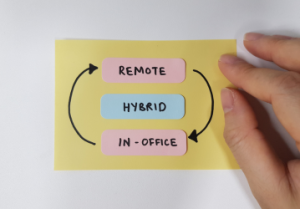there Unraveling the Pitfalls of Implementing Workplace Transformations
Unraveling the Pitfalls of Implementing Workplace Transformations
Transformation and therefore change is an inevitable part of life, and the business world is no exception. In today’s fast-paced service industry, where finance, legal, IT, and other sectors thrive, the ability to adapt and implement change is crucial. As a resilience consultant, I have witnessed both successful and failed attempts at implementing change in the workplace. In this blog, we will delve into the reasons why change initiatives often falter, and explore strategies to overcome these challenges.
The Change Conundrum
Embracing Change: A Leadership Imperative
Effective transformation starts with strong leadership commitment and a clear vision for the desired outcome. Leadership plays a pivotal role in driving and implementing successful change within an organisation.
To effectively manage change, leaders must demonstrate unwavering commitment and dedication to the process. Therefore, they need to communicate a clear and compelling vision that inspires and motivates their teams toward the desired outcome. Without strong leadership, change initiatives can falter and lose direction, leading to resistance, confusion, and ultimately failure.
Leaders must be proactive in fostering a culture that embraces change and encourages innovation. They should provide the necessary resources, support, and guidance to enable their teams to navigate through the complexities of change. By embodying the change they wish to see, leaders create a ripple effect that permeates throughout the organisation, empowering employees to embrace change, adapt, and thrive in an ever-evolving business landscape. Embracing change is not just a choice; it is imperative for leaders who aspire to build resilient and future-ready organisations.
The People Factor: Resistance and Fear
Resistance to change is a natural human response. Recognising and addressing employee concerns and fears is vital. When organisations introduce changes, whether it’s implementing new technologies, restructuring, or adopting new strategies, they often encounter resistance from every level of the organisation. This resistance is a natural human response rooted in our innate need for stability and familiarity. Change disrupts the status quo and can create uncertainty, which triggers fear and resistance.
vital. When organisations introduce changes, whether it’s implementing new technologies, restructuring, or adopting new strategies, they often encounter resistance from every level of the organisation. This resistance is a natural human response rooted in our innate need for stability and familiarity. Change disrupts the status quo and can create uncertainty, which triggers fear and resistance.
To navigate this resistance effectively, it’s crucial for leaders to recognise and acknowledge the concerns and fears. By doing so, they can address these emotions and provide reassurance and support. Open communication channels are essential during times of change, as they allow everyone to express their concerns and receive transparent information about the change process.
Leaders should actively listen to employees’ fears and concerns, demonstrating empathy and understanding. This helps create a sense of psychological safety, where employees feel comfortable voicing their apprehensions without fear of negative consequences. Addressing concerns directly and honestly can alleviate anxieties and build trust among the workforce.
Additionally, providing employees with the necessary resources and training to adapt to the change can help alleviate fear and resistance. Offering workshops, mentoring programs, or access to learning materials can empower employees to develop new skills and feel more confident in embracing the change. Support from leaders and peers can also play a vital role in easing fears and building a positive attitude toward change.
Let Everyone Be Part of the Transformation Process
Engaging employees early on and involving them in the transformation process boosts motivation and ownership. Facilitating discussions and seeking input from others can have a transformative impact when it comes to implementing change. By actively involving individuals in the decision-making process and encouraging their contributions, everyone feels a sense of ownership and belonging. When people are given the opportunity to co-create, their ideas and perspectives are valued, fostering a culture of collaboration and inclusivity.
Engaging in discussions allows for the exchange of diverse viewpoints and insights, leading to more comprehensive and well-rounded solutions. It enables the exploration of different possibilities and encourages innovative thinking. When individuals feel heard and respected, they become more invested in the outcome and are motivated to contribute their best.
Furthermore, facilitating discussions promotes transparency and accountability. It creates an environment where information is shared openly, and decisions are made collectively. This helps to build trust among team members and stakeholders, as they are aware of the rationale behind the choices made and have had the opportunity to provide input.
Involving others in the change process also helps to identify potential challenges and opportunities that may have otherwise been overlooked. People on the ground often possess valuable insights and practical knowledge that can significantly impact the success of a change initiative. By actively seeking their input, organizations can tap into this expertise and increase the chances of a positive outcome.
Ultimately, facilitating discussions and input empowers individuals, fosters a sense of ownership, and promotes a collaborative and inclusive culture. It harnesses the collective intelligence and creativity of a diverse group, resulting in more effective and sustainable change.
 Common Pitfalls and Challenges
Common Pitfalls and Challenges
Inadequate Communication: The Silence Barrier
Inadequate communication is a common pitfall and challenge that organizations face when implementing change. This pitfall is often referred to as the “silence barrier.” When there is a lack of open and transparent communication, it creates a void that is quickly filled with misinformation and speculation among employees.
Without clear communication about the reasons behind the transformation, the desired outcomes, and the steps involved, employees are left to their own devices to fill in the gaps. This can result in rumors, anxiety, and resistance to the proposed changes. Employees may start questioning the motives behind the change, creating a sense of distrust and resistance within the organisation.
Furthermore, inadequate communication can lead to a lack of understanding. When people do not fully comprehend the purpose and benefits of the change, they may not be motivated to embrace it. They might view it as an unnecessary disruption to their established routines and ways of working. This lack of understanding can hinder the adoption and implementation of the change, as employees may not see the value in it.
To overcome the silence barrier, organisations need to prioritise open and transparent communication channels. Leaders should actively communicate the reasons for the change, the intended outcomes, and the steps involved. Ultimately, they should provide opportunities for employees to ask questions, seek clarification, and express their concerns. By fostering an environment of open dialogue, organisations can address misinformation, alleviate fears, and build trust among employees.
Additionally, it is essential to establish consistent and regular communication channels throughout the change process. This could include town hall meetings, team briefings, email updates, or intranet platforms. By keeping employees informed at every stage of the change, organizations can minimize uncertainty and maintain engagement and support.
Insufficient Training and Support: The Skill Gap Dilemma
Providing adequate training and support is critical to enable employees to navigate through the new landscape. One of the primary consequences of insufficient training and support is a decrease in overall organisational efficiency. When employees lack the necessary skills to utilise new technologies or implement innovative strategies, tasks take longer to complete, and errors become more prevalent. This not only hampers productivity but also affects the quality of work delivered, potentially damaging the organisation’s reputation and customer satisfaction.
Moreover, the absence of adequate training and support can also hinder employee growth and development. In a fast-paced business landscape, continuous learning is crucial for professional advancement. When employees are left to figure things out on their own, their growth potential is limited and this lack of development opportunities can lead to demotivation, stagnation, and an increased likelihood of employee turnover.
Strategies for Success
Change Champions: The Power of Influencers
Identifying and empowering change champions within the organization helps drive acceptance and engagement. Change champions play a crucial role in driving acceptance and engagement within an organisation. These individuals are influential figures who embrace and promote change, inspiring others to follow suit. Identifying these change champions and empowering them with the necessary tools and resources enables them to effectively communicate the benefits and importance of the change initiative, thus fostering a positive attitude towards the transformation. Albeit, they are not necessarily the most senior. Change champions should be leaders who are passionate about the change. Willing to help and support the vision and mission when talking to others. They are the cheerleaders of change.
Staged Implementation: Gradual Progress for Lasting Change
Breaking down change initiatives into manageable stages ensures smoother implementation and minimizes disruption. To ensure lasting change, it is essential to implement change initiatives gradually through staged implementation. Breaking down the overall change into smaller, manageable stages not only makes it more feasible for implementation but also reduces disruption. By focusing on one stage at a time, organizations can navigate through the transformation process with greater ease and flexibility, allowing employees to adapt and integrate the changes into their routines more effectively.
Continuous Evaluation and Adaptation: The Evolutionary Approach
Regularly evaluating the change process and making necessary adjustments allows for continuous improvement. Continuous evaluation and adaptation are critical components of a successful change strategy. Organizations should regularly assess the progress and impact of the change initiative and make necessary adjustments as needed. This evolutionary approach allows for ongoing improvement and refinement of the change process, ensuring that it remains aligned with the organization’s goals and objectives. By continuously evaluating and adapting, organizations can address any challenges or barriers that arise, fostering a culture of learning and agility.
Implementing change requires a resilient mindset and a strategic approach. However, by understanding the common pitfalls and challenges that hinder successful change initiatives, managers can proactively address them. Embracing open communication, involving employees, and providing necessary support are key factors in overcoming resistance and ensuring successful change implementation. Therefore, by fostering a culture of adaptability and continuous improvement, managers can navigate the ever-evolving landscape of the service industry and lead their organizations toward growth and success.
 A Critical Challenge for UK Business Leaders
A Critical Challenge for UK Business Leaders
 Leverage Technology to Connect
Leverage Technology to Connect Your Next Steps: Leading the Connection Revolution
Your Next Steps: Leading the Connection Revolution
 The Secret Weapon of Successful UK Businesses
The Secret Weapon of Successful UK Businesses
 Case Study: Resilience in Action
Case Study: Resilience in Action In today’s fast-paced business landscape, effective communication is the linchpin of successful leadership. As a seasoned leadership and resilience coach, I’ve witnessed how refined communication techniques can transform teams and drive organisational success. This guide offers practical insights for UK business leaders to enhance their communication skills, focusing on active listening, feedback, and conflict resolution.
In today’s fast-paced business landscape, effective communication is the linchpin of successful leadership. As a seasoned leadership and resilience coach, I’ve witnessed how refined communication techniques can transform teams and drive organisational success. This guide offers practical insights for UK business leaders to enhance their communication skills, focusing on active listening, feedback, and conflict resolution.
 Welcome to our journey of embracing neurodiversity in the workplace. As an employer, I’ve always strived to create an inclusive environment where every employee feels valued and supported. However, it wasn’t until we embarked on this journey that I truly understood the importance of seeing each individual and their unique set of needs that I really fostered an understanding of neurodiversity in our workplace.
Welcome to our journey of embracing neurodiversity in the workplace. As an employer, I’ve always strived to create an inclusive environment where every employee feels valued and supported. However, it wasn’t until we embarked on this journey that I truly understood the importance of seeing each individual and their unique set of needs that I really fostered an understanding of neurodiversity in our workplace.
 In the ever-evolving landscape of the professional world, the concept of hybrid and virtual work has become more than just a trend; it’s a fundamental shift in the way teams operate. Working in resilience and leadership, I find myself at the intersection of two critical components for success in this new era: resilience and virtual work.
In the ever-evolving landscape of the professional world, the concept of hybrid and virtual work has become more than just a trend; it’s a fundamental shift in the way teams operate. Working in resilience and leadership, I find myself at the intersection of two critical components for success in this new era: resilience and virtual work.
 How to Cultivate Connection Amidst Distance:
How to Cultivate Connection Amidst Distance: Unraveling the Pitfalls of Implementing Workplace Transformations
Unraveling the Pitfalls of Implementing Workplace Transformations vital. When organisations introduce changes, whether it’s implementing new technologies, restructuring, or adopting new strategies, they often encounter resistance from every level of the organisation. This resistance is a natural human response rooted in our innate need for stability and familiarity. Change disrupts the status quo and can create uncertainty, which triggers fear and resistance.
vital. When organisations introduce changes, whether it’s implementing new technologies, restructuring, or adopting new strategies, they often encounter resistance from every level of the organisation. This resistance is a natural human response rooted in our innate need for stability and familiarity. Change disrupts the status quo and can create uncertainty, which triggers fear and resistance. Common Pitfalls and Challenges
Common Pitfalls and Challenges
 Navigating the Challenges of Implementing Change in the Service Industry: Insights from a Resilience Consultant
Navigating the Challenges of Implementing Change in the Service Industry: Insights from a Resilience Consultant programme into smaller, manageable steps to avoid overwhelming your team. Regularly evaluate progress, celebrate successes, and adjust the plan as needed.
programme into smaller, manageable steps to avoid overwhelming your team. Regularly evaluate progress, celebrate successes, and adjust the plan as needed. Navigating the Challenges: A Coach’s Perspective
Navigating the Challenges: A Coach’s Perspective
 How Coaching Can Unlock Your Team’s Potential
How Coaching Can Unlock Your Team’s Potential these challenges as opportunities for growth rather than roadblocks. They stay focused, maintain a positive mindset, and find creative solutions to overcome hurdles, fostering a culture of problem-solving within your team.
these challenges as opportunities for growth rather than roadblocks. They stay focused, maintain a positive mindset, and find creative solutions to overcome hurdles, fostering a culture of problem-solving within your team.